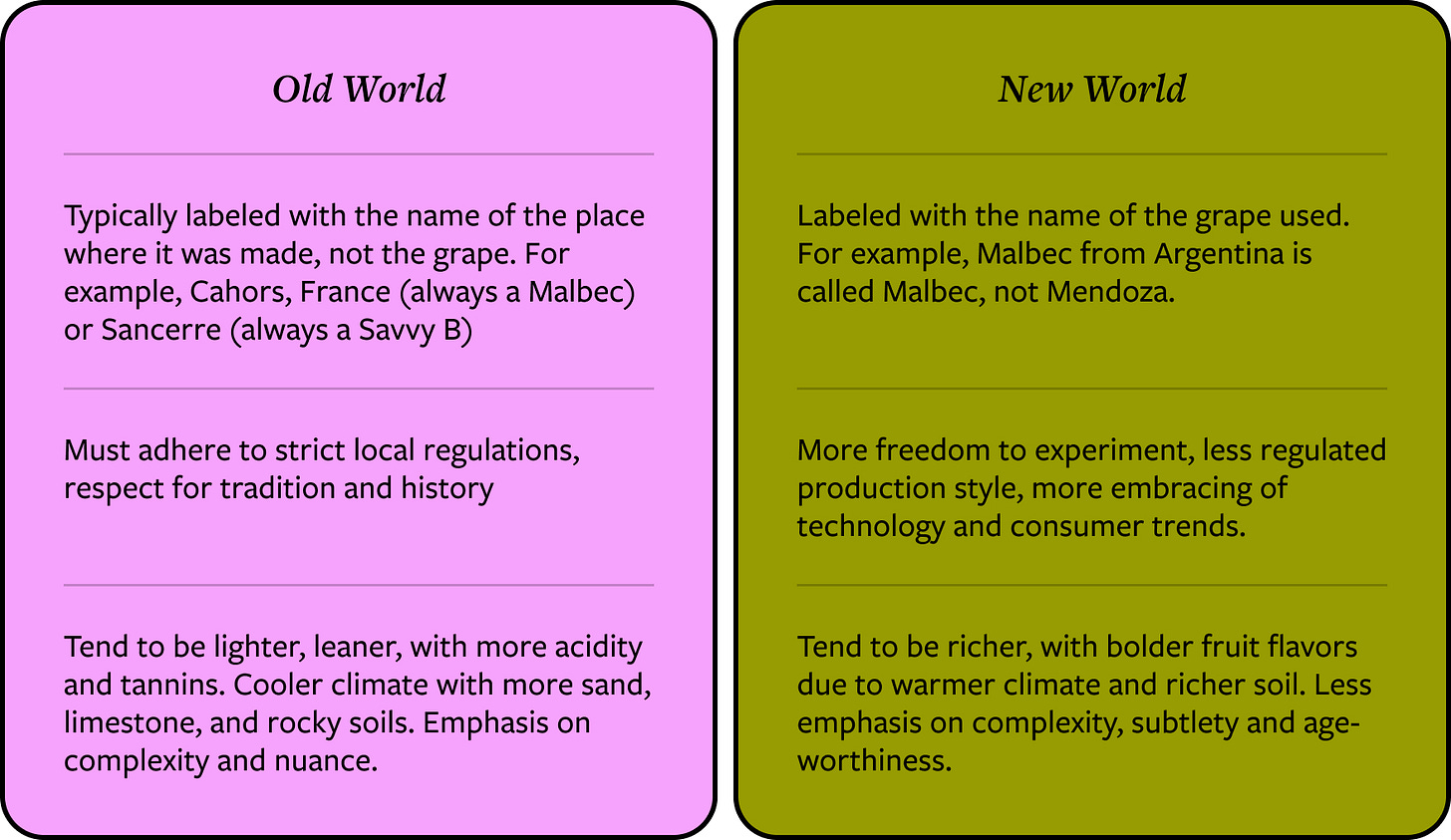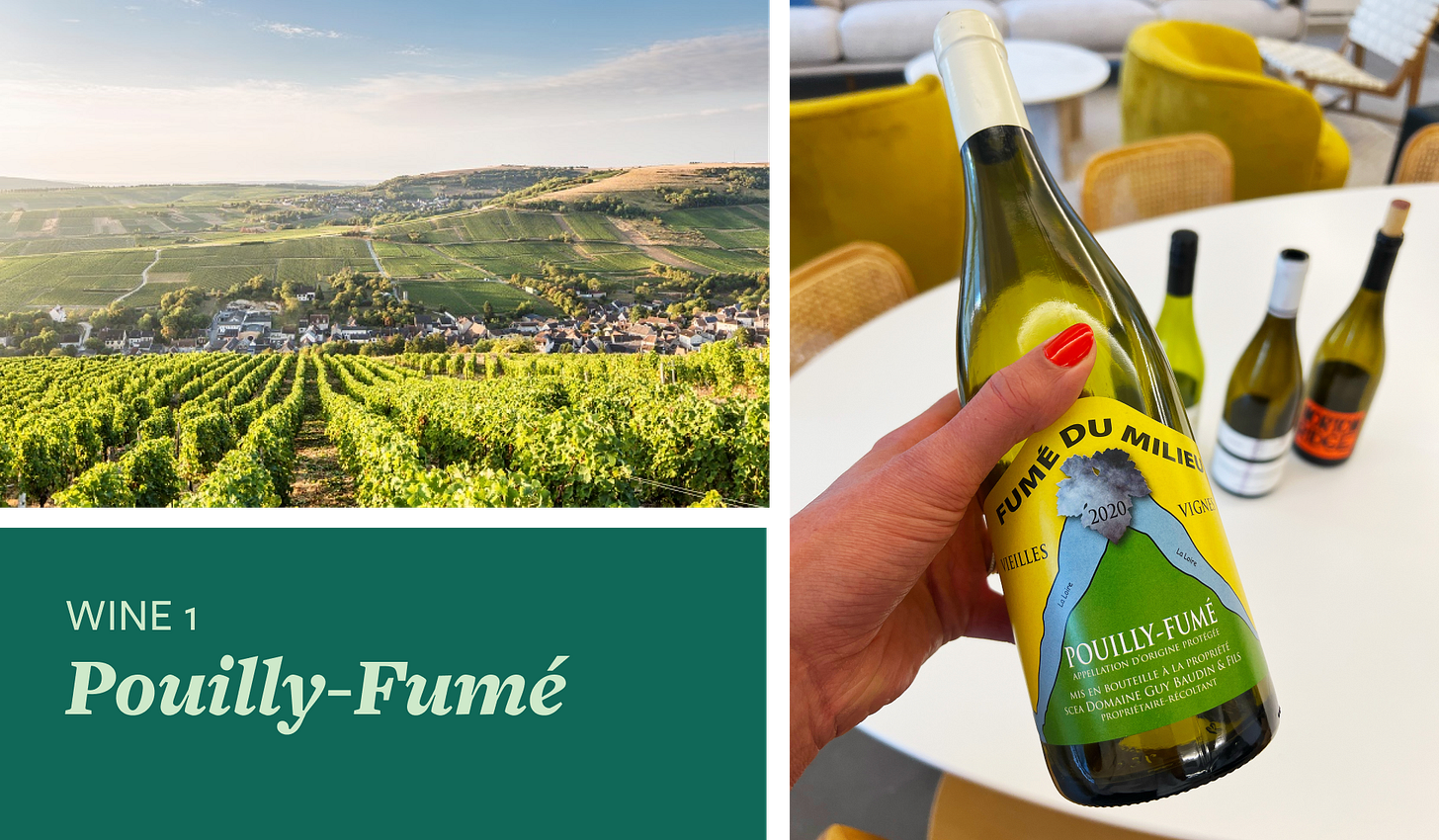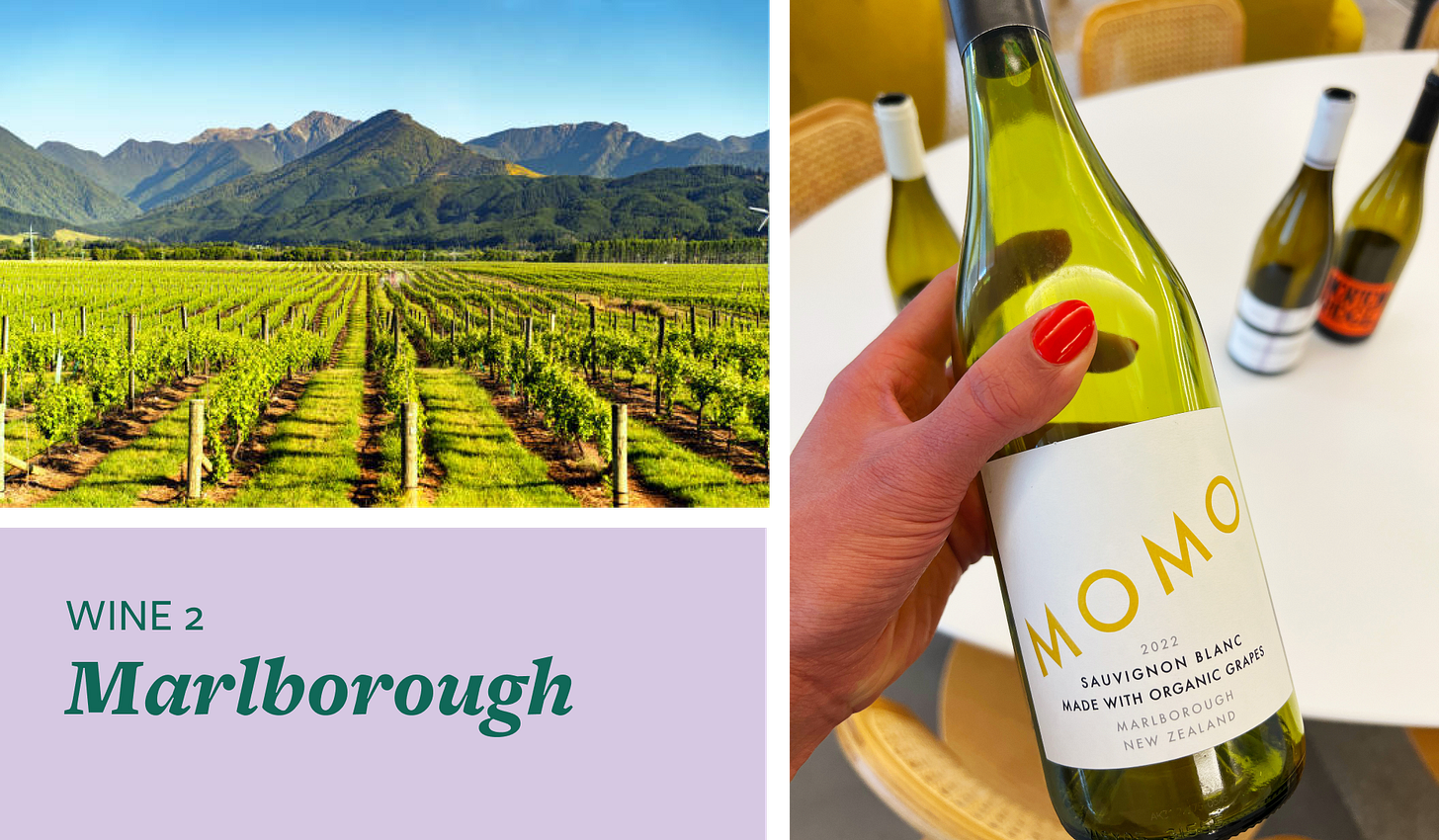Comparing 'New World' and 'Old World' wines
Let's try 4 bottles to see how region affects the taste of wine….because not all Pinot Noir is created equal
One of my favorite ways to organize wine tastings is to compare two different wines of the same grape variety — one ‘Old World’ and one ‘New World’. I am consistently reminded of how much variety can exist in wines made from the exact same grape and it’s a fun way to better understand your personal preferences and open yourself up to new styles or regions that you might not typically seek out.
This can also be a great approach for a wine tasting party — give your friends some guidance on region and varietal to share the costs while trying several new wines.
For this tasting, I chose 2 varietals; Sauvignon Blanc and Pinot Noir. These varietals have stark differences across regions and are fun to taste side-by-side.
I selected one ‘Old World’ and one ‘New World’ example of each.
I spent $20 per bottle, enough to get a quality example without breaking the bank.
Before we jump into the wines, a bit of context on why these differences exist.
What do we mean by `Old World` and `New World`
“Old World” typically refers to areas where modern winemaking traditions originated. These are the regions that exported wines, grapes, winemakers, and traditions into other countries. The Mediterranean was a hotbed of culture and civilization through history — Italy, France, Portugal, Spain, Croatia, Greece, Lebanon and Israel have been producing wines for two thousand years. Modern day Romania, Bulgaria, Austria, Hungary, Switzerland and Germany are also typically considered “Old World” countries as a part of the Roman Empire — which played a major role in the advancement of wine production.
“New world” refers to the countries that borrowed traditions from others, more often than not as a result of colonization. Since Europeans were typically the ones doing the colonizing, these are the techniques and traditions that spread the furthest. Over time, out of necessity or experimentation, these styles began to evolve, leading to what we now refer to as “New World” wine.
There are so many exceptions (especially when you consider climate change, new generations of winemakers, and advancements in technology) but here is a high level breakdown of these categories of wine:
More rules = better wine?
The general idea behind regulation is to ensure standards are met, and quality is kept high. Like most geopolitical topics, the effectiveness of this approach is highly debated.
There’s no real evidence to suggest that this yields higher quality wines and many winemakers feel the tight regulation restricts creativity and their ability to tailor their style to create the best wines with the grapes, land, weather, tools, etc. at their disposal. Less regulated regions tend to have a more entrepreneurial spirit, with winemakers developing their techniques through innovation and experimentation.
Does this approach always create better wines? Definitely not. But sometimes, yes. Experimentation leads to a lot of failures and a few wild successes.
Personally, I seek out New World wines when I am looking to try something new, interesting, trendy, or unique. Old World wines are my go-to for their consistency and reliability. There’s a place for both of these in my fridge.
Ok, let’s get into the wines!
Sauvignon Blanc
The first varietal we a diving into is the crowd favorite, Savvy B! This is a great wine to use in comparison tasting because of the wide variety of styles that exist across different regions. The European style is lighter, dryer, and more mineral driven. The New World style is fuller and delivers riper, softer, sometimes tropical fruits. I’ll share the wines I used for this tasting but there are TONS of options to choose from, I share some alternate suggestions for each to guide you at your local wine shop.
W I N E 1
Fumé du Milieu, Pouilly Fumé, $22 (Astor Wines)
For our first wine, I recommend a Pouilly-Fumé from the Loire Valley of France. This appellation produces whites from 100% Sauvignon Blanc.
Can’t fine Pouilly Fumé? Sancerre is literally across the river and shares many of the same quantities
Lots of green fruit notes (think apple, gooseberry and cut grass), citrus, steely, zingy, with the trademark minerality of this region. This is a wine I’m reaching for if I’m having bottle of wine with a nice al fresco lunch.
Chalky, gravel soils impart the flavor of gunpowder and flint, with strong, smoky minerality. The region is actually named after this unique quality of the wines — Fumé means smoke in French.
Loire Valley wines are often cited as some of the truest expressions of Sauvignon Blanc, making it a great choice for this tasting
ℹ️ Note: Pouilly-Fumé (Sauvignon Blanc) is confused with a region in Burgundy called Pouilly-Fuissé (Chardonnay). Two completely different places, two completely different wines.
W I N E 2
Momo, Sauvignon Blanc, $19 (Astor Wines)
For your comparison pick, grab a bottle of Sauvignon Blanc from Marlborough, New Zealand. Even just smelling these 2 wines, the difference is immediately noticeable.
New Zealand Sav Blanc tends to be more herbaceous and intensely flavored, still with green fruit at its core but filled out with riper, tropical fruit flavors.
Sandy soils impart good drainage and lower fertility, causing grapes to grow in lower, more concentrated yields. The wines are generally fuller-bodied and more fruit-forward, yet retain a striking acidity that keeps them fresh.
This particular example was full of citrus blossoms and stone fruits with tropical fruits like kiwi and passion fruit, but still a crisp, refreshing finish
Pinot Noir
Pinot Noir is one of the most finicky grapes to work with. Thin skinned, easily damaged by the elements, tight clustered, and usually late ripening. Pinot Noir usually thrives in places with cool climates and cloud coverage (i.e Burgundy, France), but does surprisingly well in places like Sonoma, CA. California examples tend to be much fuller, with riper fruit flavors, higher alcohol and lower acidity. Old world examples, like Burgundy, the crown jewel of Pinot Noir regions, have higher acidity and an earthier balance that tend to be a better match for foods.
W I N E 3
Coteaux Bourguignons Rouge, Leymarie-Ceci, $22 (Astor Wines)
For our first red wine, I recommend a Pinot from Burgundy. This one was a steal from Astor Wines, highly recommend if you can snag a bottle!
Affordable Burgundy can be tough to find. Wines from the Willamette Valley in Oregon have a lot of similarities to Burgundy due to the climate and can be much more wallet friendly.
Burgundy is known for its heavy cloud coverage, and cool climate with polarizing swings throughout the day which help create the acidity and texture of this wine
Minerality gives wines from this area a subtle earthiness and balance that California examples tend to lack
Red cherries and currants, with a touch of earth and warm spices, and earthy mineral notes
W I N E 4
Norton Ridge Pinot Noir, $22 (Astor Wines)
To contrast the lighter, earthy Pinot Noir from Burgundy, I recommend something from Sonoma, California. This grape surprisingly does pretty well in parts of sun-drenched California, with some of the best examples coming from coastal regions such as this example from the Russian River Valley. This region is definitely sunny and warm but has a more regulated temperature and ocean fog that brings out some really different qualities in the wine.
Pinot Noir from California is generally higher alcohol, riper, lower in acidity, and a little more fruit forward than what we tasted from Burgundy or Oregon
Russian River Valley is the warmest area of Sonoma producing fuller bodied wines with more intense fruit and a bit of sweetness
Dark forest fruits, blackberry and ground spices, with fresh herbs with a bit more tannin letting it stand up to richer, gamier foods than other Pinots
Don’t feel like you need to find any of these specific bottles! Even these regions are just the tip of the iceberg. I love doing tastings like this to discover new (to me) wines and better understand what I like and don’t like.













